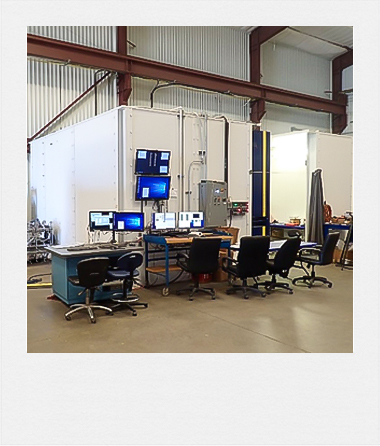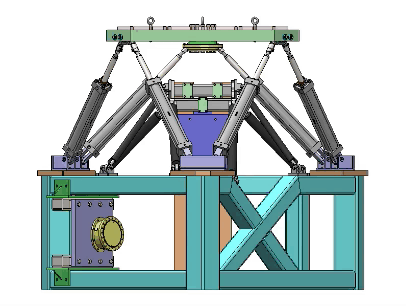Six Degrees of Freedom Rocket Engine Duct Test
You don’t have to be a rocket scientist to know that many of today’s cutting-edge rocket engines use liquid natural gas (fuel) and liquid oxygen (oxidizer) to create thrust, which pushes the rocket forward and steers it when the angle of the engine is changed by gimballing. However, the challenge lies in safely transporting these cryogenic substances into the gimballing engine, demanding robust, flexible hoses or ducts that can endure extreme temperatures, pressures, and forces.
Stress Engineering Services received a request from a private space company to perform two tests on these types of rocket engine ducts with the goals of 1) understanding how robust each duct was under peak loading conditions, and 2) generating stiffness test data for future analysis. To achieve these goals, we constructed a custom Stewart Table (or Hexapod) test frame to perform 6-degrees-of-freedom (6DOF) testing on two ducts.
During the tests, each duct outlet was anchored in the frame base. The inlet of each duct was then secured to the moving top section of the test frame, driven by six independent hydraulic cylinders. This allowed any desired combination of forces and torques in the X, Y and Z directions. The test was deemed a complete success for both the client and Stress Engineering Services.
Test data was obtained from four primary sources:
- Tri-axial strain gauges were applied to the duct exterior surfaces and supporting brackets at locations selected by the client.
- Pressure transducers monitored the internal pressures inside the various duct interior regions.
- One 6DOF load cell located at the point of loads application and six uniaxial force transducers located in line with the hydraulic cylinders measure forces and torques.
- A Digital Image Correlation (DIC) system was used to track the exact translation and rotation of the duct inlet while forces and torques were applied. This system uses precise parallax calculations between two calibrated digital cameras to calculate these geometric offsets. A second DIC system was used to monitor selected regions in the test setup and record large area strain fields.


Initial testing of the duct was completed as planned, but as higher loads were to be applied, the client believed that the test frame needed additional stiffening before continuing. Within one week, our staff modified the test frame by adding additional bracing to increase its rigidity. These modifications satisfied the client’s concerns.
Before the second duct test began, the frame stiffness was increased even further by adding 5-inch-thick steel plates.
While many of our engineers are well versed in complicated and multiple component hydraulic controls in a test fixture, we had never assembled a test stand with such a complicated interplay of cylinder interaction.
To complete the tests successfully, we applied a precise array of multiple forces and torques to the inlet end of each duct while precisely measuring its displacement. Accomplishing this goal depended on the relative stiffness of the duct test sample to the test frame. This aspect represents a challenge because the relative stiffness continuously changes as the test article deflects, causing redistribution of loads among connecting brackets and hardware on the duct. An iterative process of applying loads in small incremental steps should be employed to creep up to the target force and torque values while remaining within the allowed tolerances.
“To our knowledge, a pure load control system like this does not exist anywhere else.”
– Dr. Steven Kinyon, PE, Stress Engineering Services
Stress Engineering Services possesses the necessary experience and equipment, testing strengths, and adaptability to apply 6DOF displacement and rotation (surge, heave, sway, pitch, yaw, roll) on a test article while measuring loads and moments. This project demonstrated that the Stewart table is a useful tool for applying a complex load matrix (Fx, Fy, Fz, Mx, My, Mz) and measuring corresponding movements.
